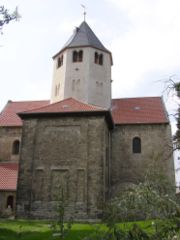
Gröningen Priory
Encyclopedia

Gröningen
Gröningen is a town in the Börde district in Saxony-Anhalt, Germany. It lies approx. 40 km south-west of Magdeburg, and 10 km east of Halberstadt. It has 4,180 inhabitants . Gröningen is part of the Verbandsgemeinde Westliche Börde....
in Saxony-Anhalt
Saxony-Anhalt
Saxony-Anhalt is a landlocked state of Germany. Its capital is Magdeburg and it is surrounded by the German states of Lower Saxony, Brandenburg, Saxony, and Thuringia.Saxony-Anhalt covers an area of...
in Germany
Germany
Germany , officially the Federal Republic of Germany , is a federal parliamentary republic in Europe. The country consists of 16 states while the capital and largest city is Berlin. Germany covers an area of 357,021 km2 and has a largely temperate seasonal climate...
.
The monastery was founded in 936 from Corvey Abbey
Corvey Abbey
The Imperial Abbey of Corvey was a Benedictine monastery on the River Weser, 2 km northeast of Höxter, now in North Rhine-Westphalia, Germany....
, of which it was a priory
Priory
A priory is a house of men or women under religious vows that is headed by a prior or prioress. Priories may be houses of mendicant friars or religious sisters , or monasteries of monks or nuns .The Benedictines and their offshoots , the Premonstratensians, and the...
, on initiative of Saxon
Duchy of Saxony
The medieval Duchy of Saxony was a late Early Middle Ages "Carolingian stem duchy" covering the greater part of Northern Germany. It covered the area of the modern German states of Bremen, Hamburg, Lower Saxony, North Rhine-Westphalia, and Saxony-Anhalt and most of Schleswig-Holstein...
Count Siegfried of Merseburg
Siegfried, Count of Merseburg
Siegfried was the Count and Margrave of Merseburg from an unknown date before 934 until his death. He does not appear with the title of margrave in contemporary royal charters and diplomas, so the title was informal and never official....
and his second wife Guthia (Jutta) upon the death of King Henry I. It became part of the Bishopric of Halberstadt
Bishopric of Halberstadt
The Bishopric of Halberstadt was a Roman Catholic diocese from 804 until 1648 and an ecclesiastical state of the Holy Roman Empire from the late Middle Ages...
and was finally dissolved in 1550 in the course of the Protestant Reformation
Protestant Reformation
The Protestant Reformation was a 16th-century split within Western Christianity initiated by Martin Luther, John Calvin and other early Protestants. The efforts of the self-described "reformers", who objected to the doctrines, rituals and ecclesiastical structure of the Roman Catholic Church, led...
.
A building of particular interest is the monastery church of Saint Vitus
Vitus
Saint Vitus was a Christian saint from Sicily. He died as a martyr during the persecution of Christians by co-ruling Roman Emperors Diocletian and Maximian in 303. Vitus is counted as one of the Fourteen Holy Helpers of the Roman Catholic Church....
, set on a slight eminence. It was dedicated in 940 by Abbot Flockmar (Volkmar) of Corvey and about 1200 re-built in the style of Hirsau Abbey
Hirsau Abbey
Hirsau Abbey, formerly known as Hirschau Abbey, was once one of the most prominent Benedictine abbeys of Germany. It was located in the town of Hirsau, in the Diocese of Speyer, near Calw in the present Baden-Württemberg.-History:...
as a Romanesque
Romanesque architecture
Romanesque architecture is an architectural style of Medieval Europe characterised by semi-circular arches. There is no consensus for the beginning date of the Romanesque architecture, with proposals ranging from the 6th to the 10th century. It developed in the 12th century into the Gothic style,...
basilica
Basilica
The Latin word basilica , was originally used to describe a Roman public building, usually located in the forum of a Roman town. Public basilicas began to appear in Hellenistic cities in the 2nd century BC.The term was also applied to buildings used for religious purposes...
with three aisles and a number of features of architectural interest. Of particular note is the very unusual octagonal crossing tower and the relief of Christ Pantocrator
Christ Pantocrator
In Christian iconography, Christ Pantokrator refers to a specific depiction of Christ. Pantocrator or Pantokrator is a translation of one of many Names of God in Judaism...
on a balustrade from the 12th century, a copy whose original is kept at the sculpture collection of the Bode Museum
Bode Museum
The Bode Museum is one of the group of museums on the Museum Island in Berlin, Germany; it is a historically preserved building. The museum was designed by architect Ernst von Ihne and completed in 1904...
in Berlin
Berlin
Berlin is the capital city of Germany and is one of the 16 states of Germany. With a population of 3.45 million people, Berlin is Germany's largest city. It is the second most populous city proper and the seventh most populous urban area in the European Union...
.
See also
- Romanesque Road

